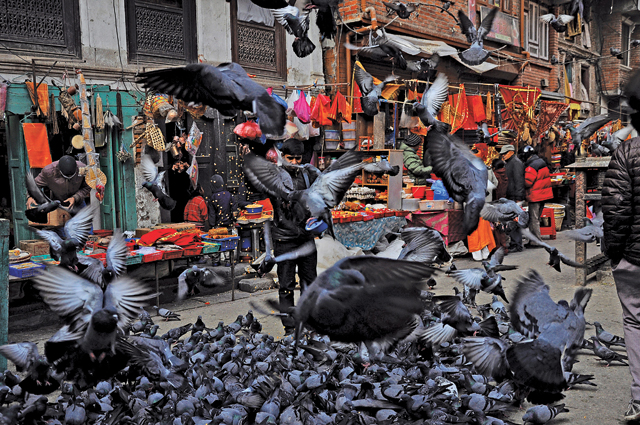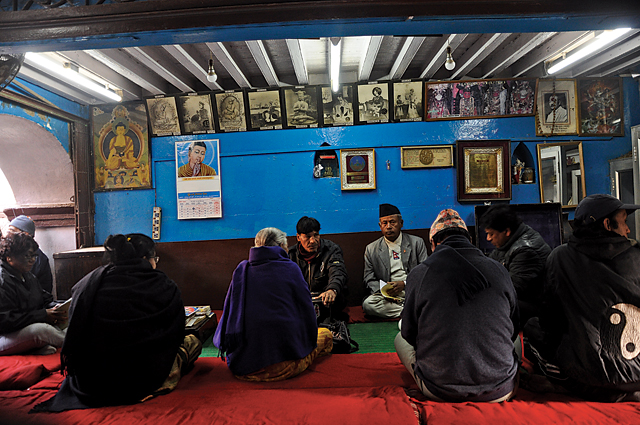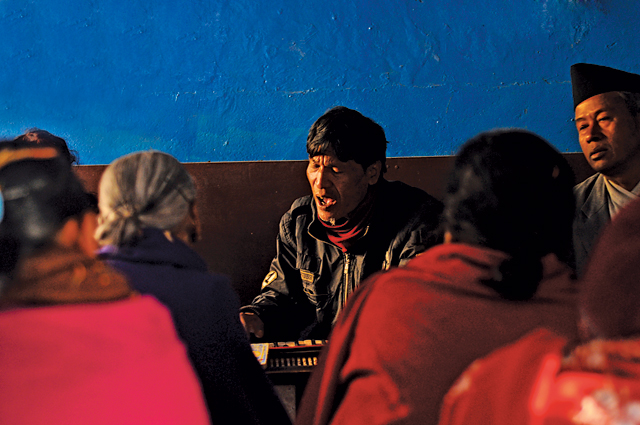Bhajan to Gods and kings aren’t just mere adulations, singing and listening to it is also a way of coming to peace with yourself.
In the early 19th century, King Rana Bahadura ?hah ordered his soldiers to banish all children of Kathmandu suffering from smallpox epidemic. The mighty king was powerless against the plague. A father before a king, he wouldn’t run the risk of his own baby child Giriv?na Yuddha Vikrama contracting the disease. Unknown to the atrocity of his father who was trying to shield him, baby Giriv?na seemed safe in his palace while the whole of Kathmandu Valley was torn apart by disease. The ruthless soldiers, following strict orders, drove away all the children suffering from the disease. Some were beaten to death with nettle and some gasped their last breath in the cold air. The sorrow sunk in deeper when the families were robbed of the ritual right of cremating their own sons and daughters. But alas, the king too would taste the helplessness when the young prince eventually did contract small pox.

Sitala maju’ is one of the most popular bhajans in the Newar society. It is mostly sung during the winter season and yet; not many know its words. The song echoes the sorrow of mothers who couldn’t help their own diseased children when the king ordered them to be sent to the eastern part of the kingdom.
When I first heard this hymn, I could instantly sense the sorrow. I could feel it wrench my heart, although I couldn’t understand its meaning. Songs can do that; it can mean so much even if it is in an alien tongue. The stories behind bhajans too have begun to fade for many of us who have been roaming their own homes as outsiders. The odes to Gods and kings have for centuries been oral histories that have now lost its pace to the speeding rhythms of modern lives. In the days to come, these songs of bhakti (devotion) that have been handed down from generation to generation might all sink into the oblivion.
The riddle of eternity, after all, is to be remembered.

Jan Bahal, just down the narrow road from Asan bazaar, reverberates with cooing pigeons and chiming bells. The sweet smell of incense in the morning is hard here. If you stand still, you can hear the day springing to life at Jan Bahal – the sounds of the turning prayer wheels, the hymns chanted by an orange robed monk, the light giggles of children running around, the low hums of people chattering behind old walls, and encircling it all, the vibrant voices of the Jan Bahal bhajan Khala: singing merry devotional songs.
On the days when I visited Jan Bahal early in the morning, I would make my way through the bustling streets with wires plugged to my ears playing western tunes. I would then hastily stash the earphone into my pocket when the bhajan would start.

I usually meet Man Krishna Wawa, the leader of the Jan Bahal Bhajan Khala:, dusting his harmonium and his companion hammering the edges of his tabla. Greeting each other ‘bhagwan sarna’ (‘Refuge in the Lord’), they look surprised to see me take one of their seats, one more time. The first song is always for Lord Ganesh and then it drifts slowly to songs for Govinda, Kali, Shiva and Saraswati.
Man Krishna Wawa often has his eyes closed when he sings bhajans. His harmonium breathes as he sings while the mandali follows him. Wawa has been singing bhajan for more than 40 years at Jan Bahal. He took up the leadership of the bhajan khala: when he was young. At the age of 13, he had already learnt playing the harmonium. His teacher would tell him “bujhe yahi ho natra bhaye hazaar” (this is it if you can understand! otherwise it’s always going to be thousands of spirally questions). “My teacher just taught me the formulas of music and that was it. And I knew what I had to do. I went on playing after that.”
I am amused to see the members of the bhajan mandali tap their thighs and enjoy the rhythm. Man Krishna Wawa sways slowly to his music, sometimes. And so, I asked one day, what I had to ask eventually: “What is it that you get when you sing these devotional songs? What’s really happening inside of you? I want to know.”

“What can really happen? I sing and dedicate my time to bhajan because I enjoy it. There is no gain with bhajan. When my day ends, I still feel good inside. I feel serene, and I think that is what keeps me going. I don’t do it because I want something from it, I just think I have been meditating
all these years through it and it calms my life,” says Wawa as he puffs a cigarette. The only time I noticed his wrinkles was when he said, “I am not sure if there is anybody after me who is going to take the lead for Jan Bahal’s bhajan. I have given my entire life to singing bhajan, and I don’t know if the new generation will take up this responsibility. Most of my students don’t show up after a week or so.”
A giant bhajan book is still locked inside a wooden box in Jan Bahal. It is the treasured history of bhajans passed down for centuries. But who will uphold this heritage in the future? Who will flip through the pages like Wawa to sing from them?
Ram Krishna Tamrakar is 72 years old, and he reminds me of my own grandfather in many ways. His eyes glimmer when he tells me about his journey.”I learnt to play the Nyakhin when I was 10. Every 10 years a tolle (community) gets a turn from the Bhajan guthi to play for Nyekhu Singha Jatra. I remember a meeting was going on inside; that day when my grandfather went out for a while, I sat and tried to play the Nyakhin. When he came back, he saw me play the instrument. He was so proud. He announced to everybody that I will be playing the Nyakhin in the jatra and he would be my master. That’s how it began.”
Tamrakar’s room is filled with testimonies his achievement. He is a master of khi tal bhajan today, but by profession he is the only Tamrakar (copper maker) left in his neighborhood. His home in Chakrabahil Chaba Ch? is constantly echoing with music. The hammering of copper produces a sound that one cannot turn deaf to. Even as Tamrakar speaks, the music in the background doesn’t fade out. And like Man Krishna Wawa, Tamrakar is worried about the future of the bhajan he devotes his time to.
But he seems content when he says his little grandson sometimes plays the nyakhi, and accompanies him to bhajans. “I think he might take interest in this; but I cannot say the same for everybody. I don’t see a young crowd when I am singing bhajans. It’s usually people of my age or people who are in their mid thirties.” Tamrakar has been part of several meetings that have been proposing ways to continue the ancestral bhajan in their community.
“So, did you find a way?” He replies: “What can you really do? You cannot force someone to learn the khi tal bhajan just because you are scared that it will cease to exist, you must live with patience and welcome anybody who genuinely wants to learn.”
“But what do you get from all of this? What do these achievements mean for you?”
“Peace. There’s nothing else to expect from it. Metal work is laborious and exhausting but when I begin my day with bhajan I feel my body never tires. It is always composed and quiet. And on days when I have more listeners to my ‘ragh’ (melody) I feel I have really achieved something. I feel happy,” says Tamrakar.
There is another form of bhajan: the Gyanmala that is gradually getting more traction with the young Newar Buddhist crowd. Gyanmala teaches Buddhist morals and values through religious stories. During the month of Gunla (the sacred month for Buddhists) this bhajan echoes through the baha bahis and other Buddhist shrines of Patan and Kathmandu. Gyanmala, (which translates to ‘garland of knowledge’), has been successful in maintaining interest among people and perhaps this is why it has more chances of having more singers in the future.
But in the few days that I had attended the bhajan mandali in Jan Bahal, I could see the hovering bleak clouds that both Man Krishna Wawa and Ram Krishna Tamrakar worried about. The audience consisted of mostly those who were shuffling through the dusks of their lives.
I did enjoy singing along merrily with the mandali. I gasped for breath once in a while; but I didn’t, for once, think of pulling my hood to sneak those earplugs out for my own music.
The writer has taken reference from Siegfried Lienhard’s Songs of Nepal. The two interviewees in the story are both masters of bhajan. Man Krishna Wawa was also one of the singers of the Newa Beatles who were quite popular in the 90’s. Ram Krishna Tamrakar is also the president of the Patan Bhajan Guthi. Bhajan are songs of devotion. Devoting a life to bhakti, as bhajan seeks to do, is another way to liberation and self-realization.









